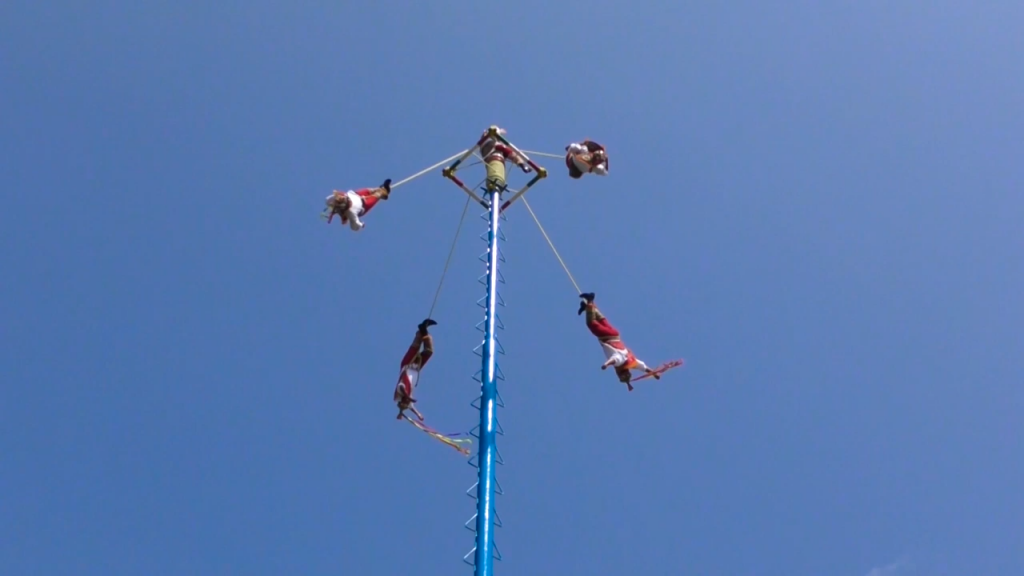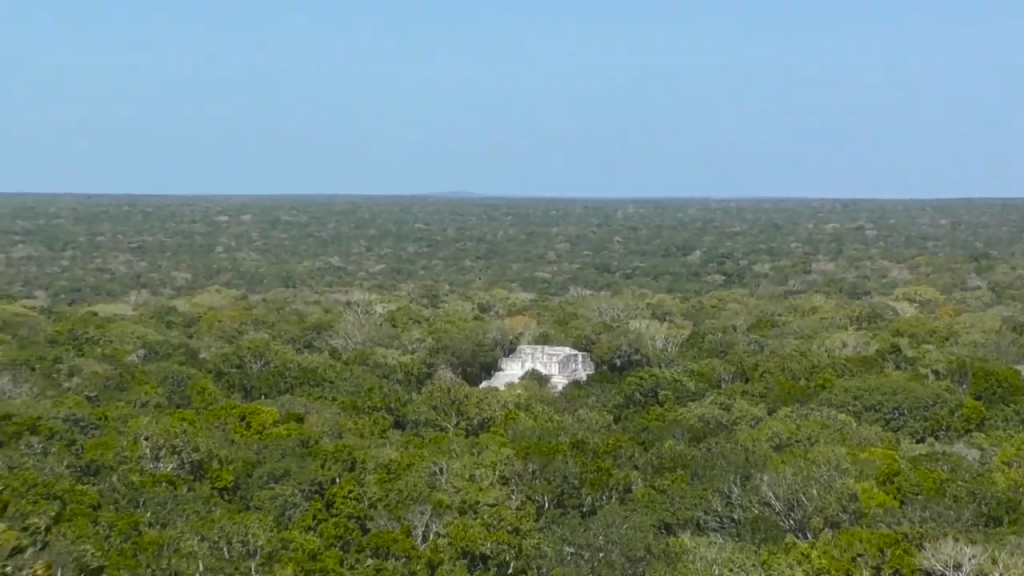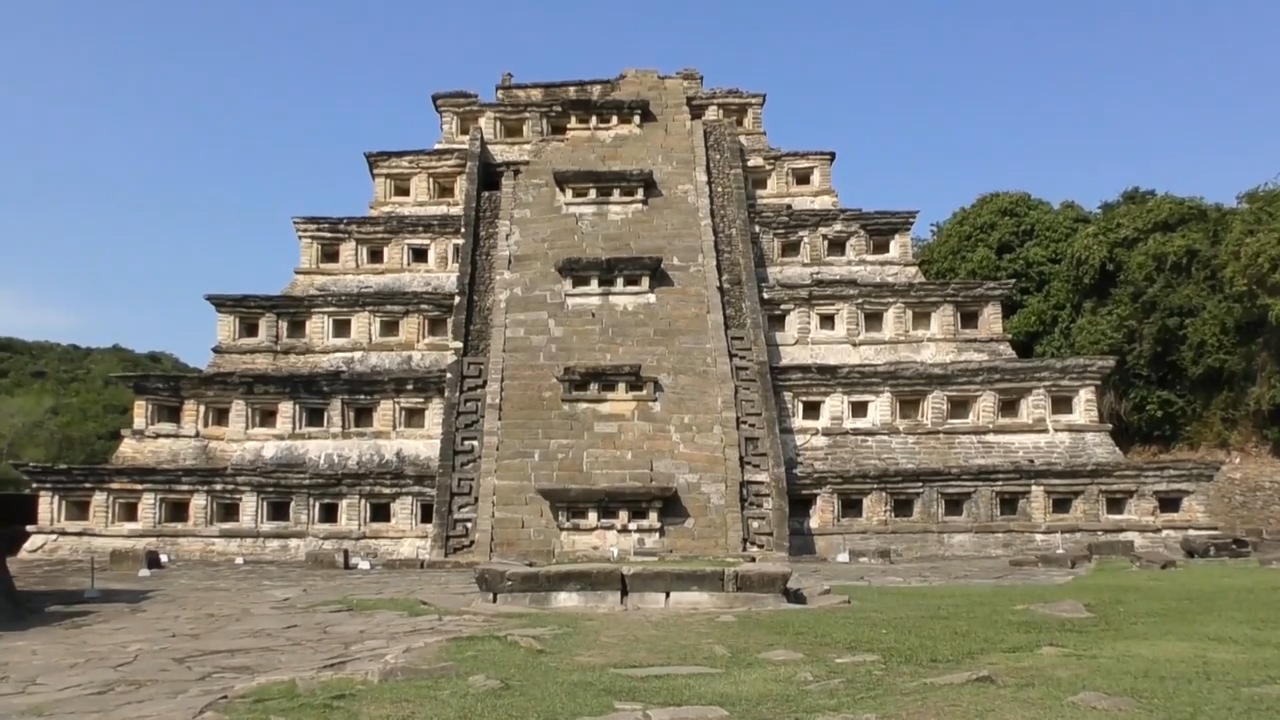The Ruins of El Tajin
A blog post by Greg

When we chose Mexico as our honeymoon destination (and unknowingly made it the first country which we would make a travel documentary about – Mexico: Mayan Mystery and Marine Majesty) I was particularly excited about seeing some of the ruins from the ancient civilisations across the country.
Our adventure had begun just outside of Mexico City at the ruins of Teotihuacan, which had been a high altitude desert ruin, following which we had driven down to the city of Poza Rica, Veracruz, where an early start got us to the ruins of El Tajin in time for the opening of the site. We had read while preparing for our journey that opening was the best time to get to almost any of the ancient sites in Mexico – not only can you beat the heat of the day, but you also find the site much quieter as the coach groups and organised tours don’t arrive until later in the day (this actually worked everywhere except for Chichen Itza when even arriving at opening had us standing in a long queue outside!).
At the entrance to the site, there are a few modern buildings – a couple of shops, a small museum and a ticket office. There is also a round courtyard space with a pole rising up into the air in the centre. Later in the day this would become the site of the ‘Flight of the Voladores’, a performance piece and ritual performed by some of the local Totonac people, in which they ascend the pole and then gently ‘fly’ back to the ground on the end of ropes which slowly unravel from the pole as it spins around.

Once we got through the entrance and walked along a small path we found ourselves among the ruins of El Tajin, and, as you can hear me remark in the documentary, if fulfilled my hopes of a ‘proper jungle ruin’. I knew that we were still planning to get deeper into jungle ruins in Palenque and Calakmul, but this was our first time seeing an ancient site surrounded by the Mexican Rainforests.
To briefly compare El Tajin with the sites at Palenque and Calakmul which we have previously written blog posts about, El Tajin feels a lot more like a museum site than the other two, which can be seen as both positive and negative. The main site which you can walk around has been fairly well cleared, with the jungle left surrounding it, which meant to me that it had an almost ‘park-like’ feel to it.
The temples are, for the most part, roped off and there are signs asking you not to climb them. After we had sat atop the pyramids of the Sun and Moon in Teotihuacan the day before, and looking back now on being able to climb to the top of structures in Calakmul and Palenque, we really missed the view from the top of these structures which gave an overview of the whole site in the other places.
Put together, the three actually give three different levels of clearance and conservation – El Tajin is very well cleared, very clean, and as I have said it is presented as more of an open-air museum.
Palenque is also largely cleared in the centre, giving a wonderful view of the site from atop the tallest structure (which you are allowed to climb, along with most of the buildings). The main buildings have been uncovered and some partially restored there, but in the main site there are still paths through the jungle, and there are many guides in the car park who can take you into the jungle around the site to see some of the structures still buried deep amongst the trees.

Calakmul is far away from the main tourist areas, and staying there requires a drive well off the main road. Three temple structures protrude above the trees, and so when you climb to the top of those you see nothing but treetops and the other two structures poking out above the trees. Many of the structures around the site still have trees protruding from them.

I would personally recommend that you visit all three of these sites if you get a chance to visit Mexico (along with Teotihuacan, Uxmal for the birds, Yaxchilan for the boat and as many other sites as you can fit in). I would, however, recommend that you visit the three sites in the order that we did, El Tajin, then Palenque, then Calakmul, as this is the perfect way to allow the remoteness and adventurousness of the sites to build as you go along.
One big difference to immediately note between Palenque, Calakmul and El Tajin is that while the other two cities were built by the ancient Maya people, it is still a matter of historical debate who first settled the site, and who built the city at El Tajin. Who constructed the site is not just a question of academic interest between historians and archaeologists, it also matters to the local people, the Totonac people (those who perform the ‘Flight of the Voladores’, who lay claim to the site as part of their communal history.
Archaeological evidence actually shows that there were hunter-gatherers in the area over seven thousand years ago, some of whom would eventually settle in the area as agriculture developed. In the 1100s BC the Olmec Civilisation, the earliest major Mesoamerican civilisation was on the rise in the Veracruz area, and so some make the argument that they are likely to have been behind the rise and building of El Tajin, however, there does not seem to have been evidence that they were in the area in large enough numbers to conclude that they were responsible for the city.
When the city itself was founded in the First Century AD a lot of evidence suggests that the area was populated not by the Olmec or the Totonac people, but by the Huastec people. Like the Totonac people, the Huastec people are still around today, and there are still upwards of sixty-thousand Huastec speakers today, of which a third live in the Veracruz area. The city reached its peak from about 600CE to 1200CE, so there is every possibility that the Huastec people may have founded the city but the Totonac people had continued it at some later point, or that one or other of these two peoples is responsible for the entire founding and building of the city, but at the moment there is not enough evidence to be sure which of these competing claims is correct.
Whoever was responsible, the site is truly impressive with a number of pyramids, and twenty ballcourts, including one with engravings showing how the games would have been played, and some of the rituals around them. The site speaks of a civilisation that was powerful, and had a great deal of knowledge about the world around them, and indeed the Sun and Moon above them, which seem to have been central to them.

One of the most interesting buildings on the site is the Temple of the Niches. This is a seven story structure, and what makes it special are the niches which cover it, of which there are exactly three hundred and sixty-five, matching with the number of days in a year. This meant that not only did the people of El Tajin have the astronomical knowledge to understand that the yearly cycle was three hundred and sixty five days, but also that they had the engineering and architectural skills to design and build a structure with exactly the right number of equally spaces niches, built of stones weighing up to eight metric tons! The amount of knowledge and skill that this would require today would make this impressive, but the idea that this was built well over a thousand years ago in a pre-industrial society just shows how amazing this site is, and why it is so worth a visit!

We are lucky to be able to visit the site today, because it was only discovered by the outside world by chance when a government inspector in 1785 was in the area searching for any tobacco plantings which would have gone against the royal monopoly laws at the time came across the Temple of Niches, although the inspector did note that the local people knew of the site.
It was in 1831 that a German architect visiting the site first gave a full description of the Temple of Niches, and just over a hundred years later in the mid 1930s the first mapping of the area and clearance of the site began, work which from 1938 was overseen by Jose Garcia Payon, who spent 39 years until his death working to uncover the site!
His work to discover and preserve this site has led to a wonderful place to visit, so if you are heading to Mexico be sure to visit if you can!
Happy adventuring, and please, take unbelievably good care of yourselves, and of each other!
Greg
P.S.
If you enjoyed this blog post, please leave a comment and say ‘hello’!
For information on all of our projects, visit: www.gregandfelicityadventures.com
Follow us on Instagram at: https://www.instagram.com/gregandfelicity
Like us on Facebook at: https://www.facebook.com/GregandFelicityAdventures
There are various places you can watch our documentaries and series!
Seeking Cetaceans In Scotland: A two-part documentary about the work of the Cetacean Research and Rescue Unit as they work to help whales, dolphins and porpoises in the Moray Firth in Scotland:
Free in the USA on Tubi TV at:
https://tubitv.com/movies/678018/seeking-cetaceans-in-scotland
Free Worldwide on PlexTV at:
https://watch.plex.tv/movie/seeking-cetaceans-in-scotland
With a library card on the Hoopla service where applicable:
https://www.hoopladigital.com/title/15313766
Free in the USA on Xumo at:
https://www.xumo.tv/channel/99991731/free-documentaries?v=XM00ILOFXCKLUC&p=74071
Buy it without ads Amazon’s Prime Video at:
UK: https://www.amazon.co.uk/dp/B09RVWVFCV
USA: https://www.amazon.com/dp/B09RVWJGY1
(Greg and Felicity are donating half of our streaming income on this documentary to support the CRRU).
Available to buy on DVD (with £5 from each donated to the charity): https://ko-fi.com/s/73e469d114
ROMANIA: SEEKING DRACULA’S CASTLE: Our travel documentary looking into the history, legend and castles connected to Vlad Dracula III, sometimes known as Vlad the Impaler, and a journey around Romania:
Free Worldwide on Plex: https://watch.plex.tv/movie/romania-seeking-draculas-castle
Free (USA) on Tubi: https://tubitv.com/movies/579192/romania-seeking-dracula-s-castle
Prime Video (From £1.99, no Ads) (UK): https://www.amazon.co.uk//dp/B08RDPZP14
Prime Video (From $1.99, no Ads) (USA): https://www.amazon.com/dp/B08RDJR4F2
TURKEY: FAIRY CHIMNEYS AND UNDERGROUND CITIES: A travel documentary across Turkey, from the Fairy Chimneys and Underground Cities of Cappadocia to the ancient Greek ruins of Ephesus and Hierapolis:
Prime Video UK (From £2.49, no Ads): https://www.amazon.co.uk/Turkey-Fairy-Chimneys-Underground-Cities/dp/B09KKSZLRW
Prime Video USA (From $1.99, no Ads): https://www.amazon.com/Turkey-Fairy-Chimneys-Underground-Cities/dp/B09KK6VDJB
Free Worldwide on Plex: https://watch.plex.tv/movie/turkey-fairy-chimneys-and-underground-cities
Free (USA) on Tubi: https://tubitv.com/movies/579225/turkey-fairy-chimneys-and-underground-cities
Greg Chapman’s Magic Show: An eight-part series of magic and entertainment with Greg:
Free in the USA on Tubi at: https://tubitv.com/series/300008713/greg-chapman-s-magic-show
Free worldwide on Plex: https://watch.plex.tv/show/greg-chapmans-magic-show/season/1
Available to buy on DVD: https://ko-fi.com/s/7c1bc10a08
Mexico: Mayan Mystery and Marine Majesty: Filmed on our honeymoon in Mexico in 2019, our first travel documentary took us through the ancient sites of Teotihuacan, Uxmal, El Tajin, Palenque, Chichen Itza and Calakmul, and then on to see the whales of Magdalena Bay, whale sharks of La Paz, and more.
Watch free on YouTube: https://youtu.be/yfMpD868MHU
The Isle of Man: Railways, Castles and Seals: Our second travel documentary took us to the Isle of Man!
Watch free on YouTube: https://youtu.be/uCpUa6XEkbg